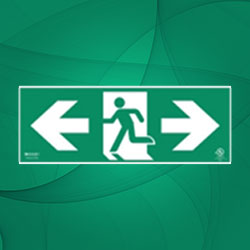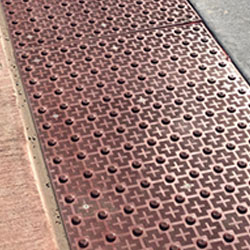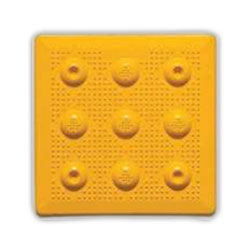

































































































































Designing accessibility from the outset enhances usability for all. This concept of “inclusive design” should shape spaces to accommodate diverse needs from the early stages. When it comes to visual impairments, a key element of accessible design involves tactile wayfinding – integrated floor guidance systems that orient users non-visually.
As Canada’s leading accessibility solution provider, we at Tactile Solutions advocate incorporating compliant tactile wayfinding into public realm projects early. This blog explores what tactile wayfinding entails, its benefits, optimal applications, and how proactive design integration enhances accessibility.
Tactile wayfinding refers to textured ground surface indicators that help users with visual impairments navigate built environments. It comprises:
Detectable Warning Surfaces: Textured indicator tiles with raised truncated domes that alert users to upcoming hazards like platforms, vehicular areas, drop-offs, and more.
Directional Guidance Paths: Ground textures with raised parallel bars or cones to delineate pedestrian circulation routes between key points.
By scanning the patterns with their feet or cane tips, visually impaired individuals orient within spaces and trace safe passages along appropriate paths.
Navigating unfamiliar environments poses difficulties for blind or low-vision users. The lack of accessible wayfinding severely limits mobility and independence. Thoughtfully planned tactile guidance fosters confidence, dignity, and autonomy by providing a reliable navigational aid.
Promotes self-sufficient mobility
Reduces disorientation & Anxiety
Indicates paths between key decision points
Alert users to upcoming hazards
Creates inclusive environments accessible to all
Proactively designing tactile wayfinding makes public spaces navigable for citizens of all abilities from the outset.
Tactile wayfinding has widespread applications across public, commercial, and institutional spaces with pedestrian traffic, including:
Public Transit Hubs: Provides orientation between platforms, ticket counters, information kiosks
Parks & Trails: Marks pedestrian walkways and highlights hazards
Plazas & Squares: Outlines safe circulation routes
Museums & Galleries: Guides visitors between exhibits and amenities
Airports & Stations: Links check-in, security, gates, baggage claim
Sidewalks & Crosswalks: Indicates safe pedestrian areas
Office Lobbies: Directs users from entries to elevators, desks, conference rooms
Shopping Centers: Helps shoppers navigate between stores, levels, and assistance points
Globally, tactile wayfinding is transforming public spaces through proactive, inclusive design practices:
London, UK: The revitalized King’s Cross Area integrates guidance paths from transit to offices, plazas, and homes.
Singapore: Extensive barrier-free access policies ensure wayfinding in train stations, bus interchanges, Housing Board estates, and more.
Seattle, USA: The redeveloped Seattle Center has a comprehensive tactile network allowing intuitive navigation between museums and attractions.
Thoughtful tactile wayfinding design makes environments more equitable for citizens of all abilities.
For maximum accessibility and safety, tactile wayfinding should adhere to recognized standards like AODA and CSA B651, which covers placement, sizing, materials, and several nuanced specifications. Our specialists actively consult on optimal product selection and layout.
Some key planning considerations include:
Logical Layout: Tactile pads relate together intuitively based on space configurations. Wayfinding should correlate to the overall floor plan.
Clear Path Dimensions: Minimum 0.6m width for two-way travel between pads without veering.
Edge Contrast: Sufficient visual tone contrast between tactile surfaces and surrounding flooring for partial sight.
Hazard Indication: Warning indicators like truncated domes are placed appropriately to identify platform edges, vehicle routes, etc.
Durability: Withstand heavy foot traffic and weather. Surfaces are slip-resistant.
Consistency: Use consistent tactile textures throughout for congruency.
Several factors play into specifying appropriate tactile wayfinding. Our team helps navigate these choices:
Surface-Applied: Affix tactile tiles post-construction
Cast-In-Place: Embed tactile markers during construction
High footfall areas require durable metal, porcelain, and polymer tiles
Simple indoor installs can utilize more economical options
Long-term exterior applications warrant 20-25 year tiles
Replaceable solutions are preferred for interior upgrades
Metal or porcelain tiles make minimal sound underfoot
Rubber, urethane, or asphalt-based materials absorb more sound
Careful deliberation of setting, costs, and future needs ensures optimal product selection.
Ideally, tactile wayfinding decisions take place early alongside overall space planning considerations. This “accessible by design” approach allows wayfinding to drive layouts versus being an afterthought addition, which compromises inclusion. Our advisors provide recommendations during the initial design phases.
Some benefits of early integration include:
Unified Spatial Language - Wayfinding seamlessly blends with floor flows versus disjointed arbitrary placement as an add-on.
Cost Optimization - Forecasting full tactile flooring needs from the outset allows more accurate budgeting and material purchasing.
Enhanced Safety - Hazard and directional guidance indicators inform layouts to maximize safety.
Streamlined Approvals - Getting sign-off on holistic, inclusive designs is faster than major retrofits.
User-Informed Design - Testing wayfinding mockups early allows user input to refine layouts.
By interweaving tactile wayfinding early in design processes, public spaces can achieve true accessibility for citizens of all abilities.
As Canada’s top tactile solution provider, our extensive product range from leading manufacturers enables compliant, durable, and affordable wayfinding for every application:
ADA-compliant polymer tiles installed into concrete walkways
Heavy-duty tiles for intense outdoor foot trafficAdvantage Tactile Systems
Customizable stainless steel indicator plates screwed into surfaces
Sleek porcelain tiles meeting slip resistance standards
Photoluminescent cast in place and surface applied stair edge nosing
With in-house technical experts providing layout and product recommendations aligned with standards, our clients achieve seamless integration of wayfinding systems into public realm projects.
Beyond moral and regulatory imperatives, proactive accessibility planning creates better experiences for all citizens. Prioritizing tactile wayfinding early in design processes ensures spaces accommodate diverse mobility from conception.
To discuss specialized product solutions or advisory services on tactile wayfinding planning, contact our team at Tactile Solution Canada today!
